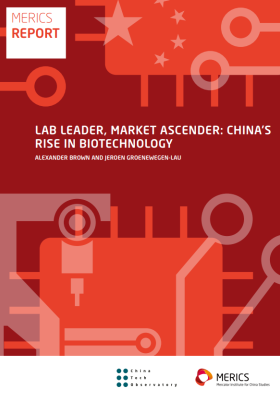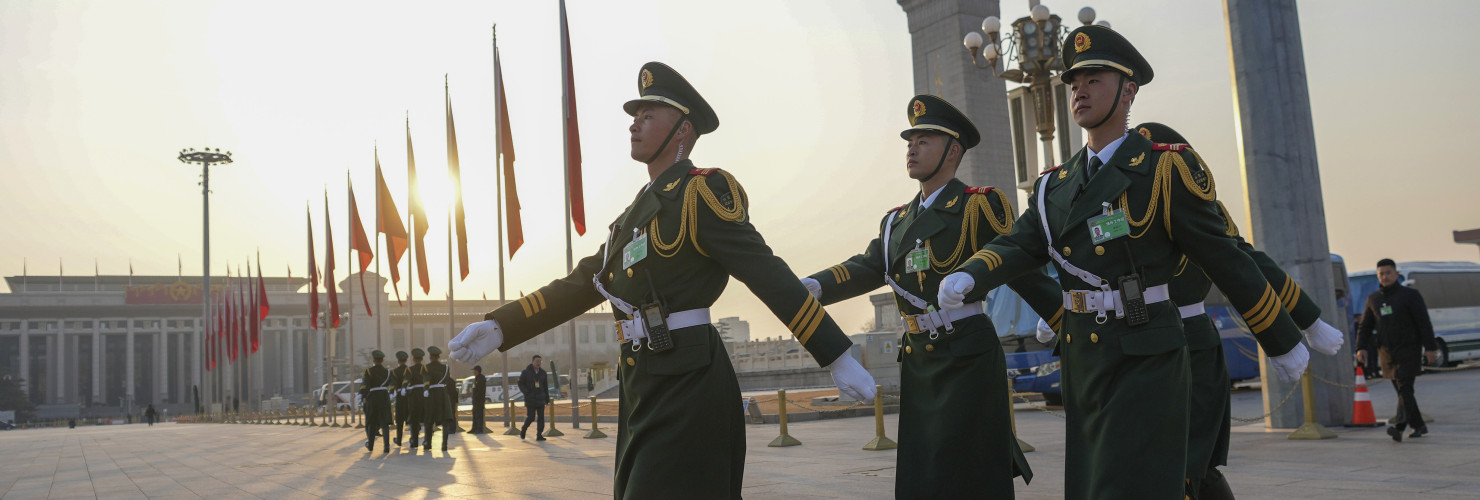

MERICS China Security and Risk Tracker 01/2025
Greater risks, greater confidence: China’s new national security white paper
Helena Legarda, Katja Drinhausen
China is a beacon of stability in uncertain times when the world is at a crossroads, facing multiple geopolitical pressure points and conflicts: this is the overarching theme of Beijing’s first white paper on national security. It was released in mid-May with great media fanfare to show the importance China’s leaders give the topic, and is titled “China’s National Security in the New Era”.
According to the white paper, China’s national security situation remains stable – a success credited to the concept of comprehensive national security coined by party and state leader Xi Jinping. The concept was introduced in 2014 and has since grown to encompass 20 areas of security (see exhibit 1). Its study is required at all levels of the party and state administration, and it guides policy choices across the board. The framework tasks Chinese officials with responding to existing threats, and with proactively identifying and tackling new dangers, using all the tools at their disposal. Its impact was visible in recent suggestions that China might use the Anti-Foreign Sanctions Law against companies that enforce US sanctions on Huawei and so could be viewed as threatening China’s economic growth. National security was also referenced in China’s imposition of new rare earth export restrictions.
The white paper showcases the changes that have taken place in Beijing’s conceptualization of national security and in its threat perceptions over the last few years:
- The international environment is now the source of some of China’s biggest challenges as relations with the United States and other Western nations are deteriorating.
- China’s economic slowdown and its potential impact on social (and political) stability is a matter of concern for the Chinese Communist Party (CCP).
- New technologies and related areas, such as data, have become firmly securitized.
- The national security system is set for further expansion, with new laws, policies and coordination mechanisms to be launched.
Despite these growing challenges, the paper’s consistent theme is confidence in China’s path and in its ability to weather the storm. Released in the final year of the current (non-public) five-year National Security Strategy (2021-2025), it gives good marks for achievement and tells cadres what comes next. It sets the path to continue China’s “dual miracle” of sustained growth and political stability.
The international sphere comes to the fore
A large introductory section is dedicated to the international environment, and the topic also features prominently throughout. Hegemonism, Cold War mentality, populism, decoupling and tariffs are some key threats that the paper identifies, and many of these problems point to the United States as the main culprit. The United States, and also the West as a whole, is described as responsible for attempts to contain China, to interfere in its internal affairs – by promoting universal values and separatism in Xinjiang, Tibet, Hong Kong and Taiwan – and to cause instability in China’s neighborhood.
Current dynamics in the Asia-Pacific region receive a separate section in the paper, one that spotlights how much Beijing worries about Washington strengthening its presence and regional alliances. The relative stability in the region is attributed to China’s constructive role – even if its neighbors may beg to differ.
Beijing will respond to the multiple regional and global challenges by going on the offensive to defend China’s interests.
The paper makes clear Beijing will respond to these multiple regional and global challenges by going on the offensive to defend China’s interests. China must move beyond preparedness, fight, and turn crisis into opportunity, it says. The party does not see the global arena solely as a source of risks. The Trump administration’s use of tariffs, and alienation of its allies and partners, has brought opportunities for Beijing to claim the moral high ground and elaborate on its role as a force for peace and stability.
Presenting China as a more responsible power and the founder of an international community of “common security”, the paper suggests Beijing will try to leverage the brewing dissatisfaction with the United States to build its own partnerships, especially in the Global South, and to weaken US alliances, particularly in Europe and the Indo-Pacific. However, the paper’s rhetorical gymnastics, in places, throw Beijing’s self-styled image as a force for peace into question. For example, it talks up China’s partnership with Russia, while simultaneously praising China’s own efforts for peace in Ukraine.
Securing development by all means necessary
The need for a favorable international environment and a more heavy-handed defense of China’s interests has domestic roots. As the white paper states: “not developing is the biggest threat” to China’s national security. This highlights the continued importance of economic growth as the foundation of the PRC’s global geopolitical power and domestic stability.
Economic resilience is front and center for Beijing, especially at a time when it is facing market restrictions abroad. The leadership wants to maximize market access abroad and protect China’s domestic market and manufacturing base to secure jobs and incomes. This is sorely needed to boost the private economy and domestic consumption as pillars of economic stability. The party also clearly perceives the need to provide enough welfare to keep China’s citizens sufficiently content to support its grand national ambitions. Expanding the ability to protect social stability through policing is also regarded as a key task in a time of transformation.
In response to these domestic imperatives, the white paper reflects a growing securitization of China’s economic and development interests, despite repeated pledges to maintain a balanced relationship between development and security. The four red lines that President Xi communicated to former US President Joe Biden in late 2024 are reiterated: the Taiwan question; China’s approach to democracy and human rights; China's path and political system, and China's development interests (发展利益). The phrasing of “national sovereignty, security and development interests”, first introduced by former CCP leader Hu Jintao in 2007, has become a staple of speeches, policy plans and legislation under Xi. Safeguarding China’s development interests also features as a goal in multiple measures linked to economic security, such as the Anti-Foreign Sanctions Law and China’s recent Unreliable Entity List.
The paper reflects a growing securitization of China’s economic and development interests.
Ensuring the international community gives China space and opportunities to fulfil its development needs has become a matter of growing importance. The paramount concern is to protect China’s market and fiercely defend its strategic and trade interests abroad, despite language committing to open China’s economy further. As Xi said in a much-quoted speech in July 2023: “If we seek development through struggle, we will develop and prosper; if we seek development through weakness and concession, we will decline.”
Security priorities are shifting
This paper shows that changes have taken place in Beijing’s understanding of security and its threat hierarchy. Political security, i.e., safeguarding the CCP and China’s political system, remains non-negotiable at the top of the list of security categories within the comprehensive national security concept. Protecting the party is the key to achieving Chinese-style modernization, national rejuvenation and unity, the paper says.
By looking at the rest of the 20 types of security, Beijing’s current priorities start to become apparent. Four new security types – financial security, food security, AI security and data security – have been added to the roster since 2022. While the paper does mention other issues to watch, such as supply chain and energy security, climate, or the domestic economy, these additions show that China’s leadership is particularly worried about the financial stability of markets and fiscal income, being able to meet the basic needs of its population, and becoming technologically self-reliant. Amid the ongoing trade and tech war with the United States, all of these are now matters of national security, and any actions deemed to threaten them will warrant tougher responses.
Protecting the security of China’s overseas interests, a pre-existing security area, has been upgraded, moving a few spaces up from the end of the list. Most likely, it has been elevated in response to Beijing’s growing concerns about the international environment, as well as reflecting Beijing’s need to secure international opportunities for development.
The national security system is set to expand further
The white paper is the latest step in a long-running process of securitization that has accelerated since Xi Jinping took office. Earlier statements on China’s comprehensive national security reflected rising risk perceptions in Beijing, but the tone has changed. The paper shows the leadership remains convinced it has chosen the right path – or at least it is projecting a high degree of confidence – and that it is ready to use current geopolitical uncertainty to advance its strategic interests and boost its global standing.
The white paper strikes a firm yet optimistic tone, boosted by China’s perceived victory in the recent tariff spat with the United States. The paper suggests that going forward, Beijing will follow a similar playbook: it will be less willing to compromise and will instead seek to expand its extraterritorial toolkit in order to stand firm and hit back against perceived attacks on areas within Beijing’s broad perception of national security. The international environment may have become more difficult and riskier for China, the white paper argues, but this time the country is better prepared and ready to struggle.
International actors should expect to encounter a more uncompromising Beijing.
To do this successfully, however, China’s “national security system” will have to be expanded. With a whole section dedicated to this issue and covering both governance and capabilities, the paper reiterates that the CCP needs to have leadership over everything pertaining to national security. It also shines a light on the next stage of implementation, by expanding the body of laws, strategies and policies related to national security. It also calls for improving prevention, foresight and rapid response mechanisms.
The buildup of laws that have an extraterritorial effect and the promotion of China’s Global Security Initiative – which is now described as the “world chapter” (世界篇) of the comprehensive national security concept – will likely have notable effects on China’s international behavior and engagements. International actors should expect to encounter a more uncompromising Beijing that is increasingly willing and able to enforce its red lines overseas, in defense of its broad national security interests.
Top China Risks 2025
We continue to identify shifts in the likelihood or probable impact of some of the 2025 top China risks identified by MERICS in late 2024. The second Trump administration’s foreign and economic policies are reshaping geopolitical dynamics, increasing tensions with both China and Europe, and leading to greater global uncertainty. Beijing’s doubling down on its partnership with Russia, and on securitizing a growing number of policy fields, exacerbates risks for Europe and other international actors. Furthermore, if US tariffs trigger the diversion of Chinese exports, there could be an impact the EU’s economic security and industrial base. Below, we outline some key developments that have altered our risk assessments.
The United States’ new China and Europe policies: Europe’s unity and de-risking agenda on China is at risk from hedging strategies
China’s overcapacity problem: The trade war and the risk of a bigger wave of Chinese exports challenges European industry
Tech entanglements and national security: China is moving to weaponize its advantages across critical value chains
China-Russia cooperation: Beijing and Moscow show they intend to build greater geopolitical coordination

China’s domestic and business environment: PLA purges, tepid consumer spending and espionage fears fuel uncertainty
Despite reoccurring labor protests, there do not seem to be any acute risks to China’s domestic stability. But new anti-corruption drives (especially in military circles), the trade war’s impact on jobs and domestic consumption and intensifying fears of espionage are all creating uncertainty within the political leadership, the private sector and the general population.
Xi Jinping’s anti-corruption drive has continued unabated across all sectors of society. High-ranking military officials keep disappearing or falling from grace, fueling rumors of internal mistrust. This year, the PLA published several commentaries on “political rectification”, highlighting the importance of anti-corruption work and loyalty to achieve full combat readiness. After years of crackdowns and ever more ambitious goals from the top, this likely sends fear of wrongdoing down the system and political networks.
Employment and livelihoods for the broader citizenry have held relatively steady. Earlier in the year, Chinese leaders published plans to increase wages and pensions, including measures to incentivize births and boost domestic consumption. Public investments beyond tech, and a renewed emphasis on manufacturing, could be stabilizing factors, but local governments face financial constraints.
Despite small upticks, economic incentives to buy goods have not yet led to lasting growth in consumption. The fallout of the trade war and market restrictions abroad are looming large, exacerbating gloomy economic forecasts, and the picture may be even worse than is known publicly. The government may be able to tame these issues through new urban and rural development plans and the growth promises of digital and AI investments, but it remains unclear how successful these plans will be.
Another repercussion of US-China tensions is the growing vigilance on both sides, which is fueling tit-for-tat witch hunts and recruitment drives for foreign agents and informants. With every aspect of citizens’ public (and often private) lives being securitized, there is a heightened risk to regular people and foreign companies in China of finding themselves entangled in the dispute.
What to watch in the months ahead
- 24-25 June: The NATO heads of government will gather in The Hague for a highly consequential NATO Summit. It is likely to be dominated by debates around European allies’ defense spending in the face of US pressure and potentially reduced engagement in Europe. This summit will also reveal how far the alliance will maintain its focus and cohesiveness on China.
- 6-7 July: The annual BRICS Summit in Rio de Janeiro will be the first for new member Indonesia, and the first gathering of BRICS leaders since the start of the second Trump administration. This year’s summit is likely to have greater geopolitical undertones, spotlighting China’s role as one of the bloc’s main drivers. Beijing is likely to push for the BRIC group’s greater institutionalization and further expansion, in hopes of turning it into a more geopolitical outfit – and it may have some success.
- July: European Commission President Ursula von der Leyen and Council President António Costa will travel to Beijing for this year’s EU-China Summit, in an early show of recalibrations in the EU’s China policy since US President Donald Trump took office. Trade-related issues are likely to top the agenda for both sides. It remains to be seen whether the EU will manage to secure commitments from Beijing to tackle key issues of concern, such as overcapacity.
- September: The UN’s 80th anniversary meeting of the General Assembly will give China a platform to push its image as a defender of multilateralism and international law, in contrast to the United States’ unilateralism.
The authors would like to thank Lily Rezepa for the research support and contributions to this edition of MERICS’ China Security and Risk Tracker.









